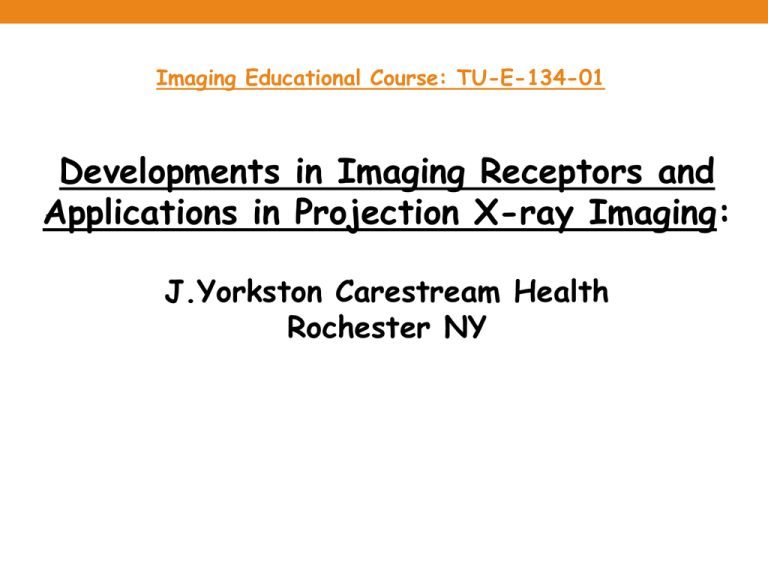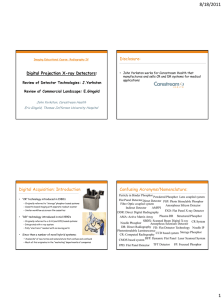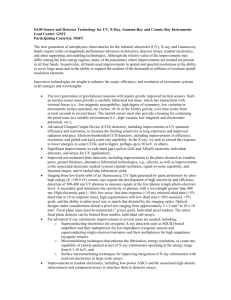Developments in Imaging Receptors and Applications in Projection X-ray Imaging:
advertisement

Imaging Educational Course: TU-E-134-01 Developments in Imaging Receptors and Applications in Projection X-ray Imaging: J.Yorkston Carestream Health Rochester NY Disclosure: • John Yorkston works for Carestream Health that manufactures and sells CR and DR systems for medical applications Digital Acquisition: Introduction • “CR” technology introduced in 1980’s – Originally referred to “storage” phosphor based systems – Cassette based imaging with separate readout scanner – Similar workflow as screen-film cassettes • “DR” technology introduced in mid 1990’s – Originally referred to a-Si:H (and CCD) based systems – Integrated with x-ray system – Fully “electronic” readout with no moving parts • Since then a number of novel hybrid systems: –“Avalanche” of new terms and nomenclature that confuse and confound – Much of this originates in the “marketing” departments of companies Educational Goals: • Identify features that define the underlying technology • Decipher confusing terminology present in marketplace – Know what questions to ask • Appreciate differences between competing approaches – All systems have their pros and cons… – Important to know which suits your application and budget • Understand recent/future developments – New detector design and system configurations – New types of “future” detectors and their capabilities Digital Image Formation: • X-rays modulated by object Incoming X-rays • X-Ray Converter/Absorber X-ray “Converter” • Secondary quanta response Response • Secondary quanta detector Detector Outline: • Discuss x-ray absorption material selection • Review secondary quantum detection options • Review current status of projection x-ray technology – Highlight new developments in designs and their rationale • Review future detector developments – New configurations (e.g. flexible substrates, “smart pixels”) – New capabilities (e.g. photon counting and energy resolution) X-Ray Absorption Materials: • Advantageous properties for an x-ray absorber include: – Absorb as many x-rays as possible – Provide accurate measure of how many x-rays interacted – Maintain information on spatial location of point of interaction – Manufacturable over suitably large physical areas • Two different types of materials used: – Phosphor materials that generate light – Photoconductor materials that generate electrical charge X-Ray Phosphors: • Two categories of x-ray phosphor materials – Prompt emission materials (e.g. Gd2O2S(Tb) also known as GOS) » Emit light “instantaneously” on absorption of x-ray » Formed basis for “modern” screen-film systems – Photo-stimulated emission materials (e.g. BaFBr(I)) » » » » » » Fraction of x-ray energy stored in long lived “latent” sites Require readout with stimulating radiation (typically laser) Also known as “storage” phosphors Formed basis for Computed Radiography (CR) systems Actually emit ~50% of energy as “prompt” light Require erasure step to remove remaining signal • Traditionally created as particle-in-binder (PIB) layers » Also known as phosphor-in-binder or POWDERED Phosphor X-Ray Phosphors: • PIB configured from small phosphor grains in plastic – Relatively “easy” to manufacture (after decades of development) – Very physically robust • Issue with creating thick layers to increase absorption – Light scatters within material – As thickness increases so does light spreading » Reduces resolution and increases noise (Lubberts effect) – Escape efficiency of light from screen varies through screen depth » Also results in increased noise (Swank noise) phosphor Air gaps binder ~100-150 mm X-Ray Phosphors: • More recently “structured” phosphors have been used – – – – – Prompt emission type: CsI(Tl) Stimulated emission type: CsBr(Eu) Reduces effect of thickness on spatial resolution: allows thicker layers Improves light escape efficiency so reduces Swank noise Allows higher “packing fraction” than PIB so higher effective absorption ~200 mm Mammo. ~500-600 mm Gen. Rad. 4 mm X-Ray Photoconductors: • Somewhat different issues than phosphors: Require applied voltage to “energize” layer and allow charge collection Internal field constrains lateral drift of released charges Near perfect spatial resolution almost independent of thickness High collection efficiency so low Swank noise Most mature material is amorphous selenium (Z=34) » Low Z value limits x-ray absorption at diagnostic energies (>60kVp) » Difficult to manufacture thick layers (~1000mm) over large area » More suited to mammographic applications (<30kVp) – Other materials include c-Si, CdTe, CdZnTe, HgI, PbI, PbO, Xenon. – – – – – ~200 mm Mammo. ~500-1000 mm Gen.Rad. E H.V. ~10V/mm Primary Photon Absorption 1.E+04 Mammo Gen.Rad. Chest Attenuation Coefficient (mu) 1.E+03 CsI(Tl) a-Se 1.E+02 1.E+01 1.E+00 1.E-01 0 20 40 60 80 100 Photon Energy (keV) 120 140 Mammo. Photon Absorption vs. Thickness a-Se ~97% 100 (28kVp Mo/Mo 5cm PMMA ) Photon Absorption (%) CsI(Tl) ~84% 10 a-Se Photon Abs. (%) CsI(Tl) Photon Abs. (%) 1 1 10 100 Thickness (microns) 1000 RQA-9 Photon Absorption vs. Thickness Photon Absorption (%) 100 CsI(Tl) Photon Abs. (%) a-Se Photon Abs. (%) CsI(Tl) ~56% a-Se ~27% 10 1 10 100 Thickness (microns) 1000 Clinical Image Comparisons: Lateral Chest (120kVp) 500mm CsI(Tl) 500mm a-Se X-Ray Absorption Materials Summary: • Can be divided into 3 main types: – Prompt emitting phospors (Gd2O2S(Tb), CsI(Tl)) – Stimulated emission phosphors (BaFBr(I), CsBr(Eu)) – Photoconductors (a-Se) • Phosphors can be sub-divided into: – Powdered or Particle-in-binder layers – Structured/Needle/Focused Phosphors • All have sufficiently good properties to be “useful” • Which is “best” depends on specifics of application Secondary Quanta Detection: • Issues are similar for phosphors and photoconductors – Need accurate measure of generated signal over large areas – Maintain image “quality” produced by x-ray absorption layer • Possible approaches include – Point by point scanning – Line scanning – Full area readout Point by Point Scanning: • Storage Phosphors/CR lend themselves to this approach – – – – – Image information “stored” in phosphor till scanned Allow time to scan whole area with small laser spot Spot ~100mm in size, 10mW power, Dwell time ~few msecs/pixel ~30 or so seconds for full readout v Laser Spot Point by Point Scanning: • Optics and mechanical motion require “large” system • Issue with collection efficiency of stimulated light – Secondary quantum sink at collection stage • One solution: read out signal from both sides of phosphor PMT Light Guide PMT Light Guide Image courtesy R. Uzenoff Fuji Medical Point by Point Scanning: • NovaRay’s ScanCath TM inverse geometry system (SBDX) • Uses large area source and small area detector – Pixellated CdZnTe photon counting detector – Transmission anode target with collimator – Excellent scatter rejection – Targetted to cardiac imaging at 30 fps. – Automatically collects tomosynthesis data Line/Slot Scanning: • To improve scan speed read out a line at a time. • With storage phosphor can readout lines after area exposure – Incorporate line laser and solid state collector in compact single unit – Significantly reduces space requirements for beam path optics – Still requires mechanical motion – Also possible with photoconductor ( e.g Thoravision) Laser Source + Intensity Control Light Collection Optics Optical Filter Beam Shaping Photodetector Image Plate (Agfa) Philips Thoravision a-Se Chest System Line/Slot Scanning: • With prompt emitting phosphors need to collimate x-rays • Numerous versions of line/slot scanned systems • Most use some form of linear CCD as detector – c-Si photon counting mammo system recently approved by FDA – Gas wire chamber based systems have also been reported • Good coupling between phosphor and CCD, good DQE • Excellent scatter rejection • Still require mechanical motion and collimation alignment • Scan times of multiple seconds • Commercial examples that used CsI(Tl) coupled & linear CCD’s include: – Thorascan (Oldelft) chest system – Senoscan (Fischer) mammo system Line/Slot Scanning: •Lodox Statscan •Full body scan 13 secs •Linear CCD with CsI(Tl) Line/Slot Scanning: •Biospace EOS •Full body scan 20 secs •Perpendicular wire/gas chambers Line/Slot Scanning: • Crystalline Si low x-ray absorption efficiency (Z=12) – – – – – Si chip fabrication uses thin layer of processed materials (~100’s mm) Not thick enough for direct x-ray absorption Increase effective thickness by rotating thin layer of c-Si Used in commercial scanning “photon counting” mammo system Takes multiple seconds for scan Philips MicroDose Full Area “Electronic” Readout: • Earliest approaches used CCD detectors 43cm 3-4cm Area Readout: Single CCD Configuration X-rays CsI(Tl) • Lens or F.O. Demag. ~x10-12 • Photon Collection Efficiency ~0.1% • 2nd quanta shot noise dominant (Secondary quantum sink) Mirror CCD High Quality Lens or Fibre Optic Reducer (Courtesy Imaging Dynamics Corp.) Area Readout: Multiple CCD Configuration • SwissRay and Apelem • reduces de-mag. (Source: SwissRay Corp.) Area Readout: Multiple CCD/CMOS Config. • CaresBuilt and Naomi • Tiling of image an issue Area Readout: a-Si:H Flat Panel Readout • Fabricated using large area a-Si:H deposition facilities • • • • 14x17” or larger readily available with pixels down to <100mm Can use prompt emitting phosphor or photoconductor Directly coupled to x-ray absorption layer (high transfer effic.) “Electronic” readout can operated in static or fluoroscopic modes Sharp Gen. 10 Glass Substrate 9x10’ Area Readout: a-Si:H Flat Panel Readout 43x43cm Pixel Area Sensing/Storage Element (Image courtesy Dr. B. Polischuk) Switching Element Area Readout: a-Si:H Flat Panel Readout • Advantages of a-Si:H readout arrays – Large area fabrication (>40cm dimensions) allowing non-tiled detector – “Mature” fabrication infrastructure (based on display industry) – Many peripheral components now available “off-the-shelf” – Excellent image quality due to high 2nd quanta collection efficiency – True “electronic” readout (no mechanical moving parts) – Advanced application capable (i.e. supports “real-time” readout speeds) – Very tolerant of radiation damage (due to amorphous structure) • Challenges for a-Si:H readout arrays – Relatively high “additive” electroinc noise – Compromises low exposure perfomance – Fabricated on “fragile” glass substrates (0.5mm thick or less) – Inherent materials properties affect “image quality” – Low carrier mobility limits “smart” pixel capabilities – Large feature sizes may limit “fill factor” of small pixels Recent Developments: a-Si:H Portable Systems •Recently, portable 14x17” & 17x17” detectors introduced • Initially rather heavy/bulky/thick with tether • More recently wireless, battery powered with cassette form factor • Smaller sized detectors (10x12”) now being introduced Recent Developments: Beam Triggered Readout • Synchronization between detector & x-ray delivery essential • Unlike screen/film and CR which are always “active” • Traditional flat panel detectors integrated with generator • New approaches have no hardwired “electrical” interface • Makes retrofitting of older systems easier Konica Aero Sync TM Recent Developments: Back Screen Config. • Concept previously used in film/screen mammography • Most advantageous when: • Energy deposition weighted towards entry side of screen (e.g. mammo) • Have low x-ray absorption substrate • Can reduce Swank noise and Lubberts Effect hence improving IQ Front Screen Config. Incident X-Rays Phosphor Pixels Substrate Signal Spread Back Screen Config. Incident X-Rays Recent Developments: Smart Pixels • Numerous research groups reported on pixel level circuitry • Main goal to amplify signal level to reduce effect of addt. noise • Issue with size of a-Si:H TFT’s which can reduce fill factor • First large area demonstration of multiple TFT a-Si:H pixels • 17x17” CsI detector, 150um pixels • 1x1 or 2x2 binning at pixel level • Improves noise performance • Adds signals before digitization From: Ito et.al. SPIE Phys. Med. Imaging 8668 (2013) 866807-1 Recent Developments: New Materials • New substrate materials • Flexible substrates e.g. plastic, metal & glass (~0.1mm thick !) • These would allow conformable, large area, very robust detectors •Available 30cmx300m for roll-to-roll proc. • New fabrication materials • Low temperature poly-Si • Has improved carrier mobilities • IGZO TM Corning Willow Glass • Compatible with large area deposition • Has better carrier mobility hence smaller feature sizes • Allows more complex circuitry at pixel level • New X-ray converters for lower dose applications • Mostly photoconductors that generate more signal per x-ray (e.g. PbI, HgI, CdTe, CdZTe, PbO) • Still mainly academic and commercial research activities Recent Developments: Flexible Substrates • Worlds first com. available curved screen TV from LG (~$10,000 !) • Uses a flexible substrate and IGZO instead of a-Si:H • 4.3mm thick !! Area Readout: CMOS Technology • Fabricated with “standard” silicon IC chip technology •Typically use standard 8” Si wafer fab. capability • Limits physical dimensions of sensor •Small feature size (<10nm) allows complex pixels • e.g. Pixel level amplification, and dose sensing • Larger sensor tiles can reduce yield and increase cost 8 inch 12 inch 18 inch (Intel) Area Readout: CMOS Technology • Recent development is “large” 3 side buttable CMOS tiles • • • • • Very low “additive” readout noise (100’s el. c.f. 1000’s for a-Si:H) High speed readout (~30+ f.p.s) Integrated electronics (e.g. ADC’s and pixel level circuitry) Directly coupled to x-ray absorption layer (high transfer effic.) High fill factor even with small pixels (<75um) 2x3 Array of Tiles Large Area Tile (~8x14cm) 23x28 cm FFDM CMOS detector Dalsa Corp. Area Readout: CMOS Technology • CMOS allows energy integrating or photon counting • Energy integrating typically utilizes CsI or GOS bonded to chip • Photon counting typically uses photoconductor (CdTe or CdZnTe) • Use of CdTe and CdZnTe currently limits size of sensor to < ~2-5 cm • Energy selective imaging is possible • Photons can be weighted according to image information “content” •Energy resolved photon counting allows multi-spectral imaging Summary: • Knowing the basic components allows for informed choices. • Storage phosphor systems: Faster, smaller and cheaper • Slow readout speeds prevent “real time” use • a-Si:H Flat Panels: Form factor and functionality (and price!) • New materials continue to be investigated • Watch for developments in display manufacturing (e.g use of IGZO) • CMOS: Increasing commercial visibility and viability • Confined to smaller area applications at present (tiled arrays) • Dental intra-oral, mammography, small field fluoro, CBCT • Excellent image quality and energy selective imaging capabilities Performance Summary: Point/Line Scanning Full Area Readout Stimulated Emission Phosphor Speed of Readout BaFBr(I) CsBr(Eu) -- - Prompt Emission Phosphor Photoconductor a-Si:H +GOS a-Si:H +CsI(Tl) CCD/CMOS lens/fib.opt. Tiled CMOS 200mm a-Se (mammo) 500mm a-Se (gen.rad.) ++ ++ +++ +++ ++ ++ (+ if integ.) (+ if integ.) Image Quality + ++ ++ +++ + +++ +++ ++ Robustness + ++ - +++ - +++ ++ - -- Size -- - + + -- + + + Cost +++ + - - +++ - - - Adv. Apps. (tomo& DE) - - + ++ + +++ ++ +




